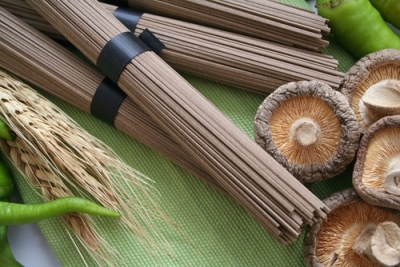The last part of any soba experience is the soba-yu, or drink.
 The yam mixture does not make the soba any more flavorful, but it does change the texture of the entire experience. This goes along with the Japanese belief that a dining experience should include all five senses if possible, so texture is just as important as taste here. There is a little added seafood flavor stemming from the seaweed of the mixture. The whole thing takes more effort to chew and it feels more satisfying. Supposedly foods that are sticky actually aid in digestion, according to Japanese research. Soba is not always filling because it is so light and fat-free. This particular type of soba is quite nourishing.
The yam mixture does not make the soba any more flavorful, but it does change the texture of the entire experience. This goes along with the Japanese belief that a dining experience should include all five senses if possible, so texture is just as important as taste here. There is a little added seafood flavor stemming from the seaweed of the mixture. The whole thing takes more effort to chew and it feels more satisfying. Supposedly foods that are sticky actually aid in digestion, according to Japanese research. Soba is not always filling because it is so light and fat-free. This particular type of soba is quite nourishing.
There are a myriad of ways to enhance the soba experience with additions or compliments to the noodles. Some people like their soba with a side of tempura, specifically shrimp tempura, which is supposed to be mild enough to enhance the flavor of the soba without overwhelming it. Some people like their soba with a side of fermented soybeans, called natto. And still others prefer their soba hot with seaweed on top. Each version of the soba experience has its own history and tradition – like the flower and the soba to represent beauty, or the seafood and the soba to bring together elements of sea and earth. These types of traditions are in the back of the Japanese mind as they eat; food is not just an experience of the mouth, but also of the mind.
The last part of any soba experience is the soba-yu, or drink. In an orange lacquer teapot with a handle on the side instead of opposite the spout, the waitress brings the water in which the soba was cooked. Like any pasta, some of the nutrients seep out of the noodle and remain in the water in which the noodle was boiled. In order to get the nutrients, the Japanese drink the water. Some people drink the water plain, but some do not. In the dipping cup, a little bit of sauce remains. The hot water is poured into the dipping cup and then enjoyed steaming hot, tasting of soba and the sauce and perhaps other spices that had previously been in the dip.
In a soba shop, there are so many elements that are the same and create an aura of comfort. Listen for the slurping sounds, smell the spices that go into the dipping sauce, and see the beautiful lacquer squares with the mound of fresh noodles on them. Like most food in Japan, soba is experiential – not just for taste but for texture, sight, smell and sound as well. The history of the food suffuses the experience so it is much more than just a meal; it is a representation of hundreds of years of history in a delicious bowl of noodles.
N.B. Special thanks to Mrs. Yumi Yamazaki for being a tasting companion, translator, fact-checker and friend.